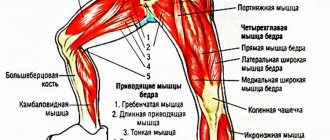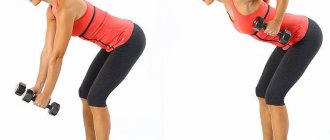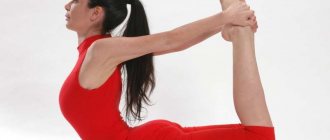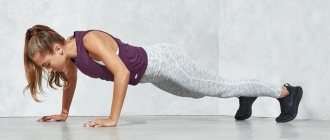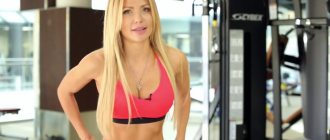Pregnancy is a period during which physical and hormonal changes occur in the body. Every day the fetus grows, and with it the load in the pelvic floor muscles increases. This is the muscle around the urethra that supports not only the bladder, but also the intestines and uterus. To feel these muscles, it is enough to stop urinating - just at this moment the desired group of muscle fibers is working.
A study conducted in Canada proved the benefits of physical activity during pregnancy, although previously it was considered dangerous to overload pregnant women. During the experiment, 5300 women were divided into 2 groups. The first one was simply observed by a doctor, without doing physical exercise. The second practiced activity according to a special program that strengthened the pelvic muscles. According to the results of the experiment, it was concluded that thanks to gymnastics for pregnant women, it is possible to reduce the likelihood of a cesarean section by 20%, and the risk of overweight baby by 31%.
Proper physical activity prevents a number of problems that arise during pregnancy - incontinence, blood congestion in the legs, hemorrhoids. With strengthened muscles, there is less risk of ruptures during childbirth and the recovery process after childbirth is faster.
Safe gymnastics for a pregnant woman in the early stages
Be sure to consult your doctor before starting any exercise routine. Only a doctor can tell you whether you can exercise or not.
A gymnastics complex for pregnant women at home may look like this:
smooth turns and tilts of the neck in different directions without sudden movements;- swings, circular movements, raising and lowering arms;
- bending the torso with the arm raised up from a sitting position on a chair;
- smooth swings of the legs sideways and back and forth, holding onto the support;
- rolling from heel to toe, walking on tiptoes;
- lifting the pelvis from a supine position;
- hanging on a horizontal bar or crossbar.
The workout is performed smoothly, 10 repetitions, without holding your breath. You can supplement the above with a Kegel complex.
- Warm-up: contract and relax the vaginal muscles at a fast pace.
- “Elevator”: squeeze the muscles located at the entrance to the vagina, and then following inward. Relax in reverse order.
The following set of exercises is absolutely not suitable for pregnant women:
- press loads;
- lifting weights;
- splits and stretching;
- sudden movements;
- intense running.
Bans are associated with the risk of premature birth. Even harmless push-ups, pull-ups and crunches can cause harm. You cannot decide on your own what exactly to do. All questions concerning the well-being of the expectant mother and the well-being of the fetus are the competence of the doctor. His recommendations are more important than advice on forums and women's sites.
Cutout
Try to give preference to sweaters with V- and U-shaped necklines. They will help take attention away from your shoulders. In addition, this way you can open your collarbones and neck, and this is always sexy and feminine. But the boat neckline visually widens the shoulders; try to avoid such cutouts.
How will regular gymnastics help expectant mothers?
In a swimming pool, gym, fitness center - wherever an exercise program is offered for expectant mothers, you can play sports if you have no contraindications. If you don’t have the opportunity or desire to go anywhere, you can train at home. A number of positive changes are worth it:
reducing the risk of serious ruptures during childbirth;- optimization of oxygen delivery processes to the child;
- relief of the condition of the expectant mother;
- improvement of metabolism in the fetus and woman;
- reduction of stress load;
- accelerated recovery of the body after childbirth;
- reducing the risk of gaining excess weight during pregnancy.
The human body is configured in such a way that nervous tension can be easily relieved. The formula for success is simple: if you are mentally tired, you need to exert yourself physically, and if overwork is associated with physical activity, it’s time to switch to intellectual activity. Properly selected exercises for pregnant women are important for expectant mothers. The emotional background will level out, and training will bring pleasure and give a bonus in the form of good physical well-being.
"Horizontals"
Remember, any horizontal lines in the shoulder area focus attention on them and visually make them wider. If you still want some accents, choose only vertical accents - fasteners or decorations, for example.
We train the pelvic floor for childbirth with special Kegel exercises
Exercises for the pelvis during pregnancy are not difficult to perform. This does not require special physical training, no special room or training equipment is required. You can train at any time of the day in a comfortable position - standing, sitting or lying down. There are three main techniques:
contraction (muscle tension for several seconds);- contraction (active alternations of compression and relaxation);
- pushing out (analogous to straining during childbirth).
The complex is repeated daily 4–5 times. At first the number of repetitions is 5–10, over time it increases to 30–40. Muscle tension lasts for 3–5 seconds at first, then increases to possible limits.
The sequence of performing gymnastics for expectant mothers:
- Tighten the muscles of the perineum for 5 seconds, relax for the same time. Repeat 10–15 times.
- Contract the muscles located at the entrance of the vagina, hold - this will be the first imaginary step or floor. Without relaxing, increase the compression a little higher. So strain your muscles to the maximum in the very depths. Then relax in the opposite direction, holding each imaginary step for 4-5 seconds.
- Contract and relax the perineal muscles as quickly as possible for 5 seconds. Relax for the same amount of time and repeat.
- Alternately tense the muscles of the vagina and anus.
Before performing pelvic floor exercises, consult with your gynecologist during your pregnancy about any contraindications.
Jumping with deep squats
If you want to lose weight in your legs faster, then you should add an element of cardio to your workout. This exercise is considered one of the best for burning thigh fat and getting a butt like a nut. Already on the fifth jump your heart will “pop out”, but if there is no painful sensation, continue doing it - your pulse should speed up, but you don’t need to jump until you become dizzy and lose consciousness.
How to do it? Place your feet shoulder-width apart, jump up and immediately lower yourself into a deep squat. From this position you need to jump out, turn your body to the right side and sit down again. Then, as you jump, turn your body to the left and jump again. You need to perform squats in all directions. Do a total of 20 repetitions (5 on each side).
What physical activity is allowed in the last trimester?
In the last trimester, the fetus actively grows and develops, pregnant women get tired and move less. Reduce the load, eliminate training on your back and standing. Possible swelling, shortness of breath and discomfort in the lower back limit physical activity, but you should not stop it completely. Even a minimal amount of training will help normalize blood pressure, soothe back pain, and prevent excess weight gain. The main condition is that you need to train when you are feeling well at a slow pace. The main positions are sitting and lying on your side.
The third trimester is characterized by increased levels of relaxin, a hormone that causes tendons and ligaments to soften in preparation for expansion. Do not overuse stretch marks to avoid ruptures. Monitor your heart rate to ensure it does not exceed 110–120 beats per minute. If you experience dizziness, nagging pain in the lower abdomen, or spotting, consult a doctor immediately. Training is contraindicated for those diagnosed with placenta previa, as there is a risk of premature birth. Even the safest gymnastics for pregnant women can be harmful if there are contraindications. Therefore, be sure to consult with your doctor before changing your activity regimen. The same applies to nutrition, taking medications and other issues.
Over the long term, the choice of training comes down to the following:
- Pilates will prepare the body for childbirth, improve blood circulation, and energize you. Exclusively a program for pregnant women, without much stress.
- Yoga will provide the necessary relaxation, and simple, basic elements will prepare the ligaments and muscles for childbirth. Heavy asanas are not practiced.
- A set of breathing practices in combination with simple yoga asanas will facilitate the birth process, calm the nervous system, and enrich the blood with oxygen.
- Water aerobics is a pleasant type of activity that does not overload the spine. You should exercise under the supervision of a trainer.
- Kegel exercises are simple and effective methods for working out the pelvic floor muscles.
- Long walks. For a long time - preferably in the company of friends and loved ones.
Decor
As we said above, the top with an “inverted triangle” should be as simple as possible, monochromatic, without volumetric details or decoration. However, you shouldn’t give it up altogether. Avoid volume, but at the same time, for example, asymmetrical elements will help draw attention away from the shoulders.
Basic recommendations and precautions
The need for moderate physical activity during pregnancy can be characterized by the motto “It is better to sit than to lie down. Better standing than sitting. It’s better to walk rather than stand.” Everything needs moderation. Organized physical activity in the absence of contraindications will not harm anyone, including pregnant women. If you don't want to exercise, you can swim. If you don't like swimming, there is breathing practice and yoga. When none of the above sparks enthusiasm, try dancing or walking more outdoors. You can choose a type of activity that will be useful and enjoyable at the same time.
The main recommendations are as follows:
- do not overheat during training - this has a negative effect on the child;
- drink more water to stimulate the removal of toxins and normalize metabolism;
- the optimal time for training is 2 hours after breakfast;
- avoid excessive stress. The presence of shortness of breath in the mother means that the baby receives less oxygen;
- control your well-being. The presence of pain in the lower abdomen is a signal to stop exercising;
- there is no point in overworking: 15 minutes is enough to stretch your muscles;
- try not to do exercises during periods when “critical days” were supposed to occur;
- do not forget about proper breathing and relaxation.
Pregnancy is a crucial period when a woman should take care of her body. If there is no evidence, there is no point in lying on the couch for 9 months. Physical education will help prepare the body for childbirth, reduce pain, improve metabolism and avoid gaining excess body weight.
What else is important when losing weight in your legs?
It's difficult to stick to a diet, make time for daily exercise, and stick to all the other rules at the same time. If it is difficult for you to suddenly change your usual lifestyle, incorporate the recommendations given into your schedule gradually.
- Move more - walk instead of using the elevator, escalator, taxi, do work while standing, give preference to active recreation instead of evenings in front of the TV.
- Gradually increase the load - do not get hung up on the same set of workouts. As soon as it becomes simple for you, move on to the next level of training.
- Do stretching exercises - pull your toes towards you, try to do the splits, bend to the sides with straight legs.
- Train regularly - do not skip classes due to laziness or lack of quick results. Everyone's metabolic rate is different, you probably just need more time for thigh fat loss exercises to work.
- Get a massage - after any load, the body needs time to recover. A good massage in a salon or at home will help speed up tissue regeneration and will be an excellent incentive for repeated training.
- Take a cool shower to avoid feeling too tired after exercise. Slightly warm water helps keep muscles toned and speeds up metabolism, which improves the effectiveness of your workout.
When you become accustomed to doing workouts, maintaining physical activity and a proper nutrition menu, move on to more complex workouts, which include not only exercises for losing weight in your legs and hips, but also allow you to develop muscle strength.
Warrior Pose II
Part 1: Stand up straight. Take your left leg back 90–120 cm, turn your toes inward about 30 degrees. With your hands on your hips and feet on the floor, face the wall, open your hips, and begin to bend your right knee toward the little toe of your right foot. Stay in this position and try to feel what is happening to your buttocks, tailbone and legs. Are you folding? Do you feel tension in your buttocks? How is your body weight distributed between both legs?
Part 2: Beginners tend to lean too heavily on the front leg. But if the gluteus medius and minimus muscles are engaged, the femur can rotate outward, allowing you to put more weight on the leg behind you.
Your hands are still on your hips to keep them in the same plane, your legs are also pressed firmly to the floor. In this position, you begin to slowly bend your left knee. This will allow you to rotate your left femur outward even more, push your hips back and, by tightening your gluteus medius and minimus muscles, press your left foot into the floor even more.
Now slowly begin to straighten your left knee, still keeping your hips open. You should feel more weight on your back leg as you do this.
Try to maintain this grounded feeling by engaging your left gluteal muscles, keeping your hips level as you exhale, and bending your right knee more so that it is over your ankle. Extend your arms out to the sides, palms down, allowing your shoulders to drop. Look at the fingertips of your right hand and hold this position for 10 deep breaths. On the last exhalation, lower your arms, and while inhaling, press harder on your left leg to rise. Now repeat the same on the other side.
Kundalini yoga
These are movements and meditations that are organically combined. In addition to a slim figure, practice clears the mind and teaches you to control your thoughts. It is good because it has no contraindications. Now let's talk about what you get by doing this technique:
- Flexible and resilient body, ready to overcome many obstacles;
- Self-discipline, good resistance to stress;
- Strengthening the immune, reproductive, nervous, digestive, musculoskeletal systems;
- Unlocking creative and spatial potential, good intuition;
- Increased awareness.
Purposefully engage in this practice and you will not only be able to lose weight, but also improve your health, put your inner world in order, and begin to live in harmony with the world and with yourself.
Half bow pose variation
Lie on your stomach, place a folded towel under your forehead. Tighten your stomach and bend your legs at a 90-degree angle, with your heels directly above your knees. Place the fingertips of both hands in the center of the gluteus maximus muscles. Tighten your butt while slightly tightening your core. Turn your legs outward slightly so that your feet touch and press lightly on each other.
As you inhale, tighten your gluteal muscles, try to lift your knees off the floor and raise your heels as high as possible. Make sure that the load is evenly distributed between the gluteal muscles and hamstrings. Hold at the top for as long as you can. As you exhale, lower yourself to the starting position.
